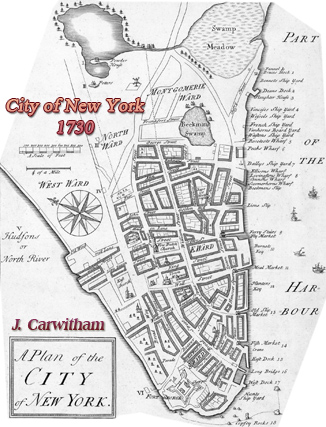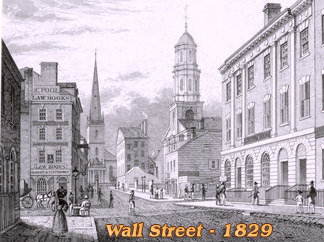Based on original records and prints in Lenox Library and New
York Historical Society. The buildings to the right are the City Hall and the
Presbyterian Church. The original Trinity Church is indicated in the distance.
The stocks, whipping-post, cage, and pillory are shown at the head of Broad
Street. Illustration drawn by Harry Fenn, published in the Harper's Monthly
Magazine, May, 1908, in the Wall Street in Colonial Times by
Frederick Trevor Hill. Source: New York Public Library. The scene was explained
in the Magazine:
«...Jeremiah Dunbar, the Recorder, was a dignified gentleman whose offices could
be required only for affairs of state, and the paper which he proceeded to read
in stentorian tones demonstrated that he was attending in his official capacity.
(...) a little group of officers sauntered up Broad Street from the direction of
Fort George and paused to learn the occasion of this proclamation to an empty
street. Solemn indeed was the occasion as disclosed by the Recorder, who with
due form and ceremony recited an order of the Council, dated October 17,
 1734,
wherein and whereby it appeared that one John Peter Zenger had set up, printed,
and published divers and sundry nefarious matters defamatory of the government
and his Excellency Governor Cosby, in a news sheet or paper known as the New
York Weekly Journal: wherefore it was decreed that certain issues of said
paper, numbered 7, 47, 48, and 49,* should be burned near the pillory at the
hands of the Common Hangman or Whipper [continue below]
1734,
wherein and whereby it appeared that one John Peter Zenger had set up, printed,
and published divers and sundry nefarious matters defamatory of the government
and his Excellency Governor Cosby, in a news sheet or paper known as the New
York Weekly Journal: wherefore it was decreed that certain issues of said
paper, numbered 7, 47, 48, and 49,* should be burned near the pillory at the
hands of the Common Hangman or Whipper [continue below]
*These and subsequent details are
derived from a rare publication in possession of the New York Bar Association,
entitled Narrative of the Case and Trial of John Peter Zenger, issued in London
in 1752.
 as
a public warning to the writer and other evil minded persons, and that the
printer should be duly prosecuted for the injurious statements contained in his
sheet. Very little of all this was sufficient to put the Recorder’s slim
audience in touch with the situation, for Governor Cosby’s recent encounter with
the local authorities over the case of the Weekly Journal was
unpleasantly familiar to all the powers that were. Indeed, every one in town
knew that his Excellency had overreached himself by ordering the Mayor and city
magistrates to attend the destruction of Zenger’s paper, and that those
functionaries, quick to resent any infringement of their liberties, had
instantly denied his right to impose any such duty upon them, and flatly refused
to lend their presence to the scene. This angry clash of authority had been
followed by a petition from the sheriff praying that the public whipper be
designated as the person to apply the torch, and when his request had been
denied, the coerced official had appointed a negro slave to act as his deputy,
and the public had decided by common consent to support the local authorities by
shunning the scene of action at the appointed hour.
as
a public warning to the writer and other evil minded persons, and that the
printer should be duly prosecuted for the injurious statements contained in his
sheet. Very little of all this was sufficient to put the Recorder’s slim
audience in touch with the situation, for Governor Cosby’s recent encounter with
the local authorities over the case of the Weekly Journal was
unpleasantly familiar to all the powers that were. Indeed, every one in town
knew that his Excellency had overreached himself by ordering the Mayor and city
magistrates to attend the destruction of Zenger’s paper, and that those
functionaries, quick to resent any infringement of their liberties, had
instantly denied his right to impose any such duty upon them, and flatly refused
to lend their presence to the scene. This angry clash of authority had been
followed by a petition from the sheriff praying that the public whipper be
designated as the person to apply the torch, and when his request had been
denied, the coerced official had appointed a negro slave to act as his deputy,
and the public had decided by common consent to support the local authorities by
shunning the scene of action at the appointed hour.
Such was the explanation of Wall Street’s deserted aspect ;
but Recorder Dunbar was equal to the occasion, and the four offending papers
were duly burned by the sheriff’s humble substitute, to the thorough
satisfaction of the spectators, who gravely watched the flames until the last
scrap was reduced to ashes, and then turned on their heels with an exchange of
formal salutes, Dunbar retiring to the City Hall and the officers to their local
barracks.
It would be difficult to imagine a more childish performance
than this whole proceeding, and even from a childish standpoint it was far from
a success, for the fire was not a good one, and its flames were poorly fed. Yet
of this tiny blaze started in Wall Street in the fall of 1734 came a mighty
conflagration which wellnigh lit a world.
John Peter Zenger, whose editorial pages were thus cleansed
with fire, was not the ablest journalist of New York, and Governor Cosby, whose
administration he attacked, was not its worst Executive. The whole history of
the city, however, had long been an inglorious recital of greed, corruption,
incompetence, and arrogance, the royal governors having included a gentleman who
made the seaport the most desirable of all piratical resorts; a noble personage
who took pleasure in masquerading in women’s clothing and exhibiting himself in
this guise, with the pleasing delusion that he might be mistaken for Queen Anne;
and a solemn nonentity who took himself so seriously that he exacted more
deference and reverence than would have been accorded to his royal master. In
fact, all the powers that were, including the landed gentry and the personal and
political favorites of the provincial court, displayed an undisguised contempt
for the masses, affecting an elegance of attire in which dress swords, ruffled
shirts, silk stockings, and short clothes served to emphasize the class
distinctions. Not all the members of this little aristocracy, however, were
Englishmen, for no more proud or exclusive dignitaries ever strutted than the
Dutch patroons, and when the ponderous travelling coach of one of those lords of
the manor lumbered down Wall Street’s cobbled roadway, on official business
bent, there were few who disdained to court recognition, while the populace
frankly stared with admiring wonder, many of them cap in hand.
It was this condition of affairs that had brought Zenger to
the front as the nominal editor and publisher of the Weekly Journal,
which had really been established and was mainly supported by James Alexander
and William Smith, two able lawyers, under whose active leadership a popular
party was rapidly forming.
Zenger himself was a young man of more courage than education,
whose boldest utterances read very mildly in these days of unbridled
denunciation, but any criticism of official actions was then regarded as
presumptuous, and his shafts evidently hit the mark, for the destruction of his
pages had been planned as a most impressive ceremony, and the humiliating fiasco
which resulted, virtually forced the government to take further proceedings in
defence of its dignity. Within ten days, therefore, Zenger was arrested at the
instance of Governor Cosby and lodged in jail, where he remained for many months
in default of excessive bail. Meanwhile the public began to take an
unprecedented interest in the affair, and under the energetic leadership of
Alexander and Smith such a strong sentiment was aroused in favor of the accused
that the Grand Jury refused to find an indictment against him, and the
Attorney-General was compelled to resort to extraordinary measures to prevent
his release. This merely intensified the popular feeling, however, and before
long all the scattered opponents of the government rallied to the slogan,
“Freedom of the Press!” and united in supporting the imprisoned editor, whose
cause immediately became a political issue of far reaching effect.
Never before had the general public been identified with any
determined effort to secure freedom of the press in America, and far seeing men
throughout the country, including Benjamin Franklin and other aspiring
journalists, watched the struggle with keen interest, while in New York the
opening moves of Zenger’s counsel resulted in such sensational developments that
the public excitement was kept at the highest pitch.
The City Hall, where Zenger had been confined, was far from a
triumph of architecture, but it was dignified and spacious, affording
accommodations for a court room, a jury room, a Council chamber, a common jail,
a library,* and a debtor’s prison, to say nothing of space reserved for the fire
department, whose water supply was partially obtained from two Wall Street
wells; and it was here that the lawyers for the defence began the proceedings
which were destined to assume historic importance...»
*Wall Street was
never a literary centre, but it housed the first collection of books known to
the city. This library subsequently became the Corporation Library, and
eventually the New York Society Library, which exists to-day.
More: Wall Street in
18th century
►
1734,
wherein and whereby it appeared that one John Peter Zenger had set up, printed,
and published divers and sundry nefarious matters defamatory of the government
and his Excellency Governor Cosby, in a news sheet or paper known as the New
York Weekly Journal: wherefore it was decreed that certain issues of said
paper, numbered 7, 47, 48, and 49,* should be burned near the pillory at the
hands of the Common Hangman or Whipper [continue below]






